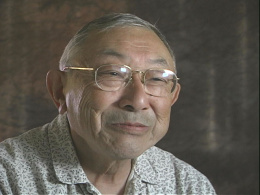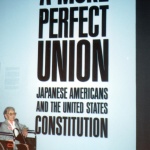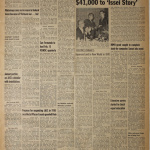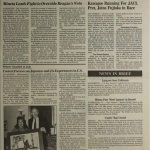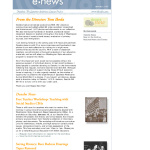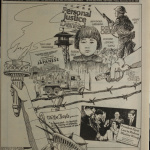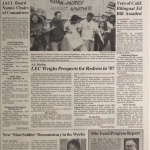Literary works on incarceration
The mass incarceration of Japanese Americans during World War II has been the focus of novels, short stories, memoirs, poems, and plays since immediately after the war.
Early Works
Published in 1945, while the war still raged, Florence Crannell Means’ young adult novel The Moved-Outers is a sympathetic account of the trials an idealized assimilated Nikkei family face after they are uprooted from a fictional California coastal town and incarcerated at the Santa Anita Assembly Center and Amache .
In 1946, two books about Japanese American imprisonment were published: Miné Okubo's illustrated memoir Citizen 13660 and Karon Kehoe's novel City in the Sun . Based on drawings accompanying letters Okubo sent to friends from the Tanforan Assembly Center , Citizen 13660 chronicles the mass removal of Japanese Americans from Berkeley, the shock of arriving at Tanforan to live in a former horse stall, the frustrations of daily life at the "assembly center," the challenging train trip from Tanforan to the Topaz concentration camp, and the desolation of Topaz. But with some humor, Okubo also depicts prisoners trying to make the most of their lives behind barbed wire. Kehoe, who worked at the Gila concentration camp, writes sensitively about conflicts between Issei and Nisei , disintegration of family life, and confusion and resentment over loyalty registration and the recruitment of Nisei soldiers. Reviewing the novel for Saturday Review , Miné Okubo wrote that she "relived vividly" her entire camp experience when reading the book.
In the twenty years following the war, a handful of literary works were published that focused on Japanese American incarceration. Respected Nisei author Hisaye Yamamoto wrote only one work set in a Japanese American concentration camp: "The Legend of Miss Sasagawara" (1950). The short story depicts the actions of and reactions to a middle-aged Nisei, a former ballet dancer, who with her Buddhist priest father are new arrivals at Poston . Her aloof and puzzling behavior intrigues and offends her fellow prisoners. Originally published in 1953, Monica Sone's memoir Nisei Daughter was reprinted in 1979 as the redress movement was building momentum. Some of the book's later chapters describe the forced removal of Sone's family to the Puyallup fairgrounds near Seattle and their incarceration at Minidoka .
While not principally about the camps, Shelley Ayame Nishimura Ota’s pioneering 1951 novel Upon Their Shoulders ends with the government arresting and incarcerating two main characters, the Issei patriarchs of their respective families, one of whom is sent to a Department of Justice camp in Arizona.
Members of a family of Japanese American flower growers in California's Santa Clara Valley are the central characters of Home Again (1955), a novel by former War Relocation Authority (WRA) employee James Edmiston. They manifest differing attitudes towards their imprisonment at the Santa Anita Assembly Center and Heart Mountain , and they endure discrimination and violence upon their return to California. Nearly half of Kazuo Miyamoto's epic novel Hawaii: End of the Rainbow (1964), about the families of two Issei immigrants, depicts incarceration of Hawaii's Japanese American community leaders in military, Department of Justice, and WRA camps in Hawai'i and on the continent.
Memoirs
One of the best known literary works about the Japanese American concentration camps, Jeanne Wakatsuki Houston and James Houston's Farewell to Manzanar (1973) has been a staple of classrooms since its publication. The book relates the Wakatsuki family's forced move to Manzanar after FBI agents arrest the family's patriarch. With descriptions of crowded quarters, bad food, lack of privacy, and the difficulty of keeping the large family cohesive amidst the chaos of mess halls and lack of activities for children, the book also recounts the Manzanar riot and conflicts over the loyalty questions and military recruitment.
Published a year after the Commission on Wartime Relocation and Internment of Civilians held hearings across the country, Yoshiko Uchida's memoir Desert Exile (1982) documents the arrest of her community-leader father and the removal of Berkeley's Nikkei to Tanforan and then Topaz. Uchida even-handedly explains why Nisei men would take differing positions on the divisive loyalty questions. She also describes the violence of embittered Issei and Kibei who attack leaders like her father who they believe are too cozy with camp administrators. Uchida would again write about wartime incarceration, but through fiction in her novel Picture Bride (1987).
Kiyo Hirano's short bilingual (Japanese-English) memoir Enemy Alien (1983) about her incarceration at the Merced Assembly Center and Amache was written as an assignment for a creative writing class at the Japantown Arts and Media Workshop in San Francisco. Minoru Kiyota's Beyond Loyalty: The Story of a Kibei was originally published in Japanese in 1990 as a novel. The English version was published in 1997 as a memoir in which Kiyota recounts incarceration at Tanforan, Topaz, and Tule Lake . Seiichi Higashide's Adios to Tears: The Memoirs of a Japanese-Peruvian Internee in U.S. Concentration Camps (1993) documents the forced deportation of a Latin American Japanese to the United States where he is interned at the Department of Justice camp at Crystal City , Texas.
Originally published in Japanese in 1981 and then translated and published in English in 2001, Tule Lake: An Issei Memoir by Noboru Shirai is frank in its accounts of theft, gambling, graft, bootlegging, youth gangs, extramarital affairs, and family strife at Tule Lake. In Looking Like the Enemy: My Story of Imprisonment in Japanese-American Internment Camps (2005), Mary Matsuda Gruenewald recalls her forced removal from Vashon Island in the Puget Sound and her incarceration as a teenager at the Pinedale Assembly Center , Tule Lake, Heart Mountain, and Minidoka. Hiroshi Kashiwagi's Swimming in the American: A Memoir and Selected Writings (2005) includes several essays and poems about his imprisonment at the Arboga Assembly Center and Tule Lake. I Call to Remembrance: Toyo Suyemoto's Years of Internment (2007) was published posthumously. Woven into the account of Suyemoto's removal from Berkeley and her life at Tanforan and Topaz are finely crafted poems she wrote during the war and later, reflecting on her imprisonment.
For a full list of memoirs, see Memoirs of incarceration .
Novels by Japanese Americans
A child when incarcerated at Tule Lake, Edward Miyakawa based his novel, Tule Lake (1979) on the accounts of University of California sociologists Dorothy Thomas and Richard Nishimoto . Told from the perspective of a Sacramento Kibei attorney, (modeled on Miyakawa's father), the novel explores why some Japanese Americans answered the loyalty questions negatively or refused to answer the questions at all. Much of Stewart David Ikeda's sweeping novel What the Scarecrow Said (1996) takes place at the Gila concentration camp where characters make decisions resulting in tragic consequences that impact the resettlement of the book's protagonist, an older Nisei man.
In her best-selling novel When the Emperor Was Divine (2002), Julie Otsuka explores a Berkeley Japanese American family's experience of wartime incarceration through multiple perspectives. Otsuka imagines preparations for incarceration through the lens of a cultured but tough Issei mother. The train ride from Tanforan to Topaz is described from the perspective of the prepubescent daughter. And Otsuka writes of life at Topaz from the point of view of the young son, who receives censored letters from his father who is interned in a series of Department of Justice camps.
Jeanne Wakatsuki Houston returns to Manzanar in her 2003 novel The Legend of Fire Horse Woman , which focuses on a strong-willed Issei matriarch who recounts her earlier life and provides solace to her unhappy daughter and guidance to her teenaged granddaughter while they are all imprisoned at Manzanar.
The Camps as Experienced or Imagined by Non-Japanese Americans
In addition to Karon Kehoe and James Edmiston, a number of other non-Nikkei have written fictional accounts about Japanese American incarceration.
A teacher and administrator at the Poston III camp, Georgia Day Robertson wrote the novel The Harvest of Hate in 1946, but it was not published until 1986. Robertson based her book on stories that Nisei teachers in Poston shared about prewar life in San Diego County (where parts of the novel take place), as well as her own observations of camp life.
The focus of best-selling Japanese author Toyoko Yamasaki's massive 1983 novel Futatsu no Sokoku (published in English in 2008 as Two Homelands ) is a Japanese American family torn apart by World War II. Parts of the novel are set in a military camp in Arizona where Japanese American community leaders are imprisoned and at Manzanar and Tule Lake. Gretel Ehrlich weaves together several plots in her novel Heart Mountain (1988), including stories focused on the relationship between a white rancher and a Japanese American artist incarcerated at Heart Mountain, the Issei cook of the rancher's family, and a former University of California graduate student also imprisoned at Heart Mountain.
Best-selling romance novelist Danielle Steel set her 1996 interracial love story Silent Honor in part amid the imprisonment of Japanese Americans at Tanforan and Tule Lake. Tule Lake during the weeks after martial law was declared in 1943 is the backdrop for Marnie Mueller's novel The Climate of the Country (1999), which is based on the experiences of her parents, Donald and Ruth Elberson, who worked at Tule Lake.
Part coming-of-age story, part murder mystery, Sandra Dallas's novel Tallgrass (2007) takes place in the fictional Colorado prairie town of Ellis, which borders Tallgrass, Dallas's fictionalized Amache. The book's thirteen-year-old narrator witnesses the townspeople's hostility towards Japanese American prisoners increase after the rape and murder of a classmate. But she also sees her beet farmer parents withstand the ignorance, hatred, and vitriol of their neighbors by hiring workers from the camp and treating them with respect.
A large part of Sophie Littlefield’s 2013 novel Garden of Stones takes place in Manzanar, where staff members sexually abuse an attractive Nisei widow and her teenage daughter. A key plot point hinges on a historical improbability— the government allowing a Nikkei teenager to live and work in Lone Pine, a small town several miles south of Manzanar.
Baseball is the prism through which Jay Feldman imagines Japanese American incarceration in Suitcase Sefton and the American Dream , the story of a New York Yankees baseball scout who discovers a southpaw Nisei pitching ace incarcerated at Gila.
Anthologies
Ayumi , a 1980 bilingual (English and Japanese) collection of short stories, memoirs, poems, and visual art by Issei, Nisei, Sansei , and Yonsei includes a number of pieces focused on wartime imprisonment and postwar resettlement.
The anthology From Our Side of the Fence: Growing Up in America's Concentration Camps (2001) is a collection of short memoirs by eleven Nikkei who were children or youth when incarcerated. The authors wrote their pieces as students in an Internment Autobiography Writing Workshop sponsored by the Japanese Community and Cultural Center of Northern California, led by writer Brian Komei Dempster, who edited the volume. A follow-up collection, Making Home From War: Stories of Japanese American Exile and Resettlement (2011), includes pieces by the same authors about their adjustments to post-camp life.
Novels Influenced by Wartime Incarceration
Although not necessarily about life in the camps, a number of novels either partially take place in camps or deal with the repercussions of Japanese American incarceration.
The earliest and perhaps most important of these books is John Okada's 1957 novel No-No Boy . Set in Seattle at the end of World War II, this bildungsroman focuses on the struggle of 25-year-old Ichiro Yamada to reclaim his identity as an American and to understand why he answered "no" to the loyalty questions that all Japanese Americans adults were forced to answer while imprisoned. That the book was rejected by Japanese Americans when it was published is not surprising given that it reveals deep, painful and lasting divisions within the Nikkei community resulting from disagreements over the loyalty questions.
Jacqueline Briskin’s 1970 novel California Generation , about a group of students who come of age in the 1960s, includes a Sansei character who was born in Topaz and is embittered by the economic losses his family suffered because of the mass incarceration
Max Templeman's melodramatic novel Kibei (1979) follows a Fresno Kibei and his family from the Fresno Assembly Center and Tule Lake to their postwar lives in Japan, Los Angeles, and New York. Chikara!: A Sweeping Novel of Japan and America From 1907 to 1983 (1984) by Robert Skimin centers on an extended family in Japan and the U.S. The book touches on the imprisonment of some family members in the Stockton Assembly Center and Manzanar.
Cynthia Kadohata's debut novel The Floating World (1989), a picaresque narrative about an itinerant Japanese American family in the 1950s and 1960s, is influenced by the backstory of Japanese American dispersion after wartime imprisonment. Two main characters in David Guterson's best-selling novel Snow Falling on Cedars (1994) marry in Manzanar, and wartime wrongs and racism continue to impact the postwar life of the small Puget Sound town where the novel is set. Heart Mountain is the site where one of the characters in A Bridge Between Us (1995), Julie Shigekuni's novel about four generations of Japanese American women in San Francisco, makes a life-altering decision that impacts future generations.
Sections of Rahna Reiko Rizzuto's novel Why She Left Us (1999), which explores the multigenerational ramifications of the illegitimate pregnancies of a young Nisei, are set in the Santa Anita Assembly Center and Amache. Hotel on the Corner of Bitter and Sweet (2004), Jamie Ford's touching love story between a Chinese American youth and a Japanese American classmate takes place, in part, against the backdrop of the imprisonment of Seattle's Japanese American community in Minidoka. Sections of John Hamamura's novel Color of the Sea (2006), the story of a Kibei, take place in the Stockton Assembly Center and Rohwer .
In his dystopian novel 21st Century Manzanar (2002), Perry Miyake envisions Manzanar re-opened for new generations of Japanese Americans in the early 21st century after the U.S. government scapegoats Japan for an economic collapse.
Nina Revoyr’s 2003 mystery Southland follows a Yonsei law student who investigates the suspicious deaths during the 1965 Watts Riots of four young black men in the freezer of a market owned by her Nisei grandfather in Los Angeles’ racially mixed Crenshaw district. Parts of the novel take place in Manzanar, where the protagonist’s grandparents were incarcerated as young adults, and in Heart Mountain where another character is incarcerated. Revoyr also imagines the 442nd regiment’s battles in Italy and their rescue of the Lost Battalion.
Like No-No Boy , the shadow of incarceration envelopes David Mura's haunting novel Famous Suicides of the Japanese Empire (2008), which depicts the ramifications of a Nisei's draft resistance at Heart Mountain on his family in postwar Chicago. Jane Smiley frames her 2010 novel Private Life with the bombing of Pearl Harbor and the incarceration of Japanese Americans, friends of the book's protagonist, at the Tanforan Assembly Center.
Poetry and Drama
Acknowledged as the first book of poetry by an Asian American released by a major publisher, Lawson Inada's 1971 collection Before the War: poems as they happened is also the first book of poems to include works about Japanese American wartime imprisonment. Several poems are portraits of camp life, including the poet's childhood recollections. Inada returns to World War II in two subsequent collections: In Legends from Camp (1993) the eponymous poem is a reflection on fact and euphemism, history and memory, framed through various "legends" from the Fresno Assembly Center, Jerome , and Amache. In Drawing the Line (1997), the title poem is a tribute to a Heart Mountain draft resister.
James Masao Mitsui's 1974 collection Journal of the Sun includes poems depicting the train ride to Tule Lake (where Mitsui and his family were incarcerated) and a Nikkei child leaving Bainbridge Island . In Crossing the Phantom River (1978), Mitsui pays tribute to Miné Okubo and imagines Tule Lake and the Bismarck Department of Justice camp.
Born in Japan and raised in Seattle among Nisei peers, Mitsuye Yamada is the only woman of her generation to publish a book of poetry including work focused on Japanese American incarceration. Camp Notes and Other Poems (1976) features a cycle of poems depicting her family's forced removal from Seattle to her imprisonment at Minidoka and her resettlement in Cincinnati.
Incarcerated as a child in Rohwer, Janice Mirikitani frequently focuses her poems on Japanese American concentration camps and their ramifications. In her books Awake in the River (1978), Shedding Silence (1987), and We, the Dangerous (1995), Mirikitani gives voice to her mother, aunt, and other women victimized by the mass incarceration, often drawing parallels between abuse of women and the racism and constitutional violations suffered by Nikkei during the war.
In his poetry collections After We Lost Our Way (1989), The Colors of Desire (1995), and Angels for the Burning (2004) David Mura imagines his parents and grandparents at Heart Mountain and Jerome, as well letters between an Issei interned at a Department of Justice camp and his wife in a WRA camp. Nisei draft resisters, JACL leaders and Gordon Hirabayashi also appear in poems in which Mura tries to understand a history buried by his parents who have not spoken of their wartime incarceration.
Ishmael Reed selected Lee Ann Roripaugh's Beyond Heart Mountain (1999) as the 1998 National Poetry Series winner. The collection includes a central section, entitled "Heart Mountain, 1943," a series of ten internal monologues each in the voice of a different prisoner. In "The Wartime Letters of Hideo Kubota," a section of his 2011 book of poems Coral Road , Garrett Hongo imagines what a Kibei from Hawai'i interned at the Department of Justice camp in Leupp , Arizona, would write to various poets from around the world.
The central and eponymous poem of Claire Kageyama-Ramakrishnan’s 2008 debut collection Shadow Mountain (winner of the Four Way Books Intro Prize in Poetry) focuses on the experiences of her father’s family and others who were incarcerated at Manzanar, as well as her own visit as a child to the site of the camp. In her follow-up book, Bear, Diamonds, Crane (2011), Kageyama-Ramakrishnan explores family memories (or lack thereof) of wartime incarceration, her desire to understand that period and the legacies of racism and resilience among generations of her family.
Numerous plays about Japanese American incarceration and its aftermath have been written and produced, but only two, Wakako Yamauchi's 12-1-A and Hiroshi Kashiwagi's The Betrayed , have been published. The title of Yamauchi's play refers to the Poston address of the Tanaka family, the play's main characters. 12-1-A was first produced in 1982 by the East West Players in Los Angeles just months after the Commission on the Wartime Internment of Civilians hearings. The play focuses on a year in the lives of widowed Mrs. Tanaka, her, twenty year old son and seventeen year old daughter, and their relationships with a brash young Nisei woman from Terminal Island , a developmentally disabled Nisei man, and others in Poston. Kashiwagi's short two-character play The Betrayed centers on the romance between a young Nisei couple in the Tule Lake camp, their conflicts over the loyalty registration, and their reunion forty years later. For a complete list of produced plays, see Plays on incarceration .
The spectrum of literary works about the World War II incarceration of Japanese Americans—from a mass market romance novel to formal poetry—has expanded public understanding of the complex emotional and psychological impacts of the mass imprisonment on individuals, families, and communities. Many of these publications have, in turn, inspired critical and scholarly analyses, which add depth to our knowledge of the historical, social, and cultural significance of Japanese Americans' wartime experiences in concentration camps.
Related Articles
List of Books
Early Works
Edmiston, James. Home Again . Garden City, New York: Doubleday & Company, 1955.
Kehoe, Karon. City in the Sun . New York: Dobbs Mead & Company, 1946.
Means, Florence Crannell. The Moved-Outers . Boston: Houghton Mifflin, 1945.
Miyamoto, Kazuo. Hawaii: End of the Rainbow . Rutland, Vt.: Charles E. Tuttle, 1964.
Okubo, Mine. Citizen 13660 . New York: Columbia University Press, 1946.
Ota, Shelley Ayame Nishimura. Upon Their Shoulders . Foreword by Miles E. Carey. New York: Exposition Press, 1951.
Sone, Monica. Nisei Daughter . Boston: Little, Brown and Company, 1953. Rpt. Seattle: University of Washington Press, 1979.
Yamamoto, Hisaye. "The Legend of Miss Sasagawara." Kenyon Review 12.1 (1950): 99-115.
Memoirs
Gruenewald, Mary Matsuda. Looking Like the Enemy: My Story of Imprisonment in Japanese-American Internment Camps . Troutdale, Ore.: New Sage Press, 2005.
Higashide, Seiichi. Adios to Tears: The Memoirs of a Japanese-Peruvian Internee in U.S. Concentration Camps . Honolulu: E and E Kudo, 1993. Rpt. Seattle: University of Washington Press, 2000.
Hirano, Kiyo. Enemy Alien . San Francisco: JAM Publications, 1983.
Houston, Jeanne Wakatsuki, and Houston, James. Farewell to Manzanar . Boston: Houghton, 1973.
Kashiwagi, Hiroshi. Swimming in the American: A Memoir and Selected Writings . San Mateo, Calif.: Asian American Curriculum Project, 2005. [Includes the play The Betrayed .]
Kiyota, Minoru. Beyond Loyalty: The Story of a Kibei . Honolulu: University of Hawaii Press, 1997.
Shirai, Noboru. Tule Lake: An Issei Memoir . Sacramento: Uteki Press, 2001.
Suyemoto, Toyo. ' 'I Call to Remembrance: Toyo Suyemoto's Years of Internment . New Brunswick, N.J.: Rutgers University Press, 2007.
Uchida, Yoshiko. Desert Exile . Seattle: University of Washington Press, 1982.
Novels by Japanese Americans
Houston, Jeanne Wakatsuki. The Legend of Fire Horse Woman . New York: Kensington Publishing Company, 2003.
Ikeda, Stewart David. What the Scarecrow Said . New York: ReganBooks, 1996.
Miyakawa, Edward. Tule Lake . Waldport, Ore.: House by the Sea Publishing Company, 1979.
Otsuka, Julie. When the Emperor Was Divine . New York: Viking, 2002.
Uchida, Yoshiko. Picture Bride . Flagstaff, Ariz.: Northland Press, 1987.
The Camps as Experienced or Imagined by Non-Japanese Americans
Dallas, Sandra. Tallgrass . New York: St. Martin's Press, 2007.
Ehrlich, Gretel. Heart Mountain . New York: Viking, 1988.
Feldman, Jay. Suitcase Sefton and the American Dream: A Novel . Chicago: Triumph Books, 2006.
Littlefield, Sophie. Gardens of Stone . Don Mills, Ont., Canada: Harlequin, 2013.
Mueller, Marnie. The Climate of the Country . Willimantic, Conn.: Curbstone Press, 1999.
Robertson, Georgia Day. The Harvest of Hate . Fullerton: Oral History Program, California State University, Fullerton, 1986.
Roosevelt, Kermit. Allegiance . New York: Regan Arts, 2015.
Rubin, Jay. The Sun Gods . Seattle: Chin Music Press, 2015.
Steel, Danielle. Silent Honor . New York: Delacorte Press, 1996.
Yamasaki, Toyoko. Two Homelands . Honolulu: University of Hawaii Press, 2008.
Anthologies
Dempster, Brian Komei, ed. From Our Side of the Fence: Growing Up in America's Concentration Camps . San Francisco: Kearny Street Workshop, 2001.
———. Making Home from War: Stories of Japanese American Exile and Resettlement . Berkeley, Calif.: Heyday, 2011.
Mirikitani, Janice, et al. eds. Ayumi: A Japanese American Anthology . San Francisco: Japanese American Anthology Committee, 1980.
Novels Influenced by Wartime Incarceration
Briskin, Jacqueline. California Generation: A Novel . Philadelphia: Lippincott, 1970.
Ford, Jamie. Hotel on the Corner of Bitter and Sweet . New York: Ballantine Books, 2004.
Guterson, David. Snow Falling on Cedars . New York: Harcourt Brace, 1994.
Hamamura, John. Color of the Sea . New York: St. Martin's Press, 2006.
Kadohata, Cynthia. The Floating World . New York: Viking, 1989.
Miyake, Perry. 21st Century Manzanar: A Novel . Los Angeles: Really Great Books, 2002.
Mura, David. Famous Suicides of the Japanese Empire . Minneapolis: Coffee House Press, 2008.
Okada, John. No-No Boy . Rutland, Vt.: Charles E. Tuttle, 1957.
Revoyr, Nina. Southland . New York: Akashic Books, 2003.
Rizzuto, Rahna Reiko. Why She Left Us . New York: HarperCollins, 1999.
Shigekuni, Julie. A Bridge Between Us . New York : Anchor Books, 1995.
Skimin, Robert. Chikara!: A Sweeping Novel of Japan and America from 1907 to 1983 . New York: St. Martins/Marek, 1984.
Smiley, Jane. Private Life . New York: Knopf, 2010.
Templeman, Max. Kibei . Honolulu: Daimax Publishing House, 1979.
Poetry and Drama
Hongo, Garrett. Coral Road . New York: Alfred A. Knopf, 2011.
Inada, Lawson Fusao. Before the War: Poems as They Happened . New York: William Morrow, 1971.
———. Legends from Camp . Minneapolis: Coffee House Press, 1993.
———. Drawing the Line . Minneapolis: Coffee House Press, 1997.
Kageyama-Ramakrishnan, Claire. Shadow Mountain . New York: Four Way Books, 2008.
———. Bear, Diamonds, Crane . New York: Four Way Books, 2011.
Mirikitani, Janice. Awake in the River . San Francisco: Isthmus Press, 1978.
———. Shedding Silence . Berkeley: Celestial Arts, 1987.
———. We, the Dangerous . Berkeley: Celestial Arts, 1995.
Mitsui, James Masao. Crossing the Phantom River . Port Townsend: Graywolf Press, 1978.
———. Journal of the Sun . Port Townsend: Copper Canyon Press, 1974.
Mura, David. After We Lost Our Way . New York: E.P. Dutton, 1989.
———. The Colors of Desire . New York: Anchor Books, 1995.
———. Angels for the Burning Rochester, NY: BOA Editions, 2004.
Roripaugh, Lee Ann. Beyond Heart Mountain . New York: Penguin, 1999.
Yamada, Mitsuye. Camp Notes and Other Poems . San Lorenzo, Calif.: Shameless Hussy Press, 1976. Rpt. Latham, N.Y.: Kitchen Table: Women of Color Press, 1992.
———. "Desert Run: Poems and Stories . Latham, N.Y.: Kitchen Table: Women of Color Press, 1988.
———. Camp Notes and Other Writings . New Brunswick, N.J.: Rutgers University Press, 1998. [Includes both Camp Notes and Desert Run .]
Yamauchi, Wakako. 12-1-A . In The Politics of Life: Four Plays by Asian American Women , edited by Velina Hasu Houston. Philadelphia: Temple University Press, 1993.
Last updated Oct. 19, 2020, 2:44 p.m..

 Media
Media
